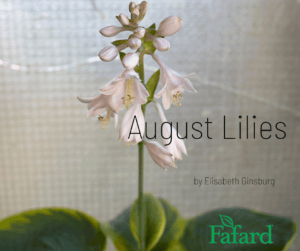
When people think of hostas, they imagine mounds of lush green or variegated leaves that bring style and substance to shady areas.
They do not think of flowers.
That’s because hosta flowers are typically smallish, purplish trumpets that appear in early summer atop gawky, nearly-naked stems that generally seem too tall for the plants. Fastidious gardeners often clip off the stems, choosing to glory in the leaves and forget about the flowers.
But those gardeners have never met Hosta plantaginea, commonly known as “August lily”.
Why is this hosta, sometimes also know as Corfu lily, white plantain lily, white daylily, or Japan lily, a star among the hundreds of varieties in the hosta universe? An average plant is medium-sized, with a maximum height and spread of about 18 inches. The flower stalks grow taller, soaring to 30 inches. While the heart-shaped, medium green leaves are attractive, other species and hybrids boast more notable leaf color or texture.
The one feature that truly defines the August lily is the species’ large, trumpet-shaped flowers—The waxy, white trumpets, which are three to four inches long flare in all directions atop the stalks, projecting a divine, honeyed fragrance. If the breeze is coming from the right direction, you can pick up the scent of an established clump from many feet away.
The blooms are so beautiful and substantive that they are worthy of cutting for indoor arrangements. They also attract hummingbirds.
August lilies set themselves apart by producing this magnificent show during the dog days of summer, much later than other species. They can also stand a bit more sunlight than other hostas.
Unlike most traditional hostas, which are descended from plants native to Japan, members of the plantaginea species descend from Chinese natives. They arrived in England back in 1790 and sailed across the Atlantic to the newly formed United States after that. The compelling scent of the flowers made them garden favorites and they are sometimes still billed as heirloom or old-fashioned plants. Though the name “August lily” describes the time of bloom, plantagineas are not and never have been true lilies, which belong to a different plant family.
Modern gardeners have rediscovered plantagineas because they are as ridiculously easy to grow as any other hostas, but have a little something extra–the ability to produce new leaves during the growing season. Most other hostas sprout only one crop of leaves annually. If those leaves are damaged by slugs or deer, you are out of foliar luck for the season. If you have August lilies, you can get out the repellant spray and apply it to the fresh young leaves in the hopes of a better outcome the second time around.
The plantaginea breeding picture has historically been complicated by the fact that the plants do not flower at the same time as other hosta species. Still, breeders have persevered and plantaginea hybrids, complete with the intoxicating fragrance, are commercially available. ‘Royal Standard’, one of the best, is a giant among its peers, featuring glamorous white trumpets atop green foliage that may spread to over five feet.
If you are paging through catalog offerings in search of sweet-smelling hostas or trolling the nursery sniffing out bargain plantagineas, look for variety names that start with the word “fragrant”. Like other hostas, plantaginea varieties and hybrids may bear variegated leaves, which add interest in months other than August. The large-leafed variety, ‘Fragrant Bouquet’, is an award winner with medium green leaves edged in cream Left to its own devices, it may grow up to forty-eight inches wide. The tasty sounding ‘Fried Bananas’ features the same fragrant white flowers as its plantaginea relatives, but also boasts golden-green leaves.
If you are a small-space or container gardener, take heart. ‘Sugar Babe’ a fragrant-flowered, variegated variety descended from plantagineas and other species, grows only 10 inches tall and 16 inches wide.
No matter which August lily you choose, position the plants where they can be appreciated for their beautiful flowers and divine scent. They are perfect for path edges, areas under frequently- opened windows, or near sitting areas. Give them rich soil amended with a quality product like Fafard Natural and Organic Compost, and light to medium shade. The plants will do the rest.
August lilies and their hybrids are, like most other hostas, good investment plants. After the first two or three years, you can divide them and increase your stock. That means more fragrance, most gorgeous flowers and possibly more hummingbirds zipping around. The dog days don’t get much better than that.
.
About Elisabeth Ginsburg

